I am working on a Xamarin.Forms PCL project that displays posts in the form of a WebView so I add clickable content such as hashtags.
The problem I am having is the WebView doesn't adjust to the size of its content. The WebView does not load an actual site I am binding the HTML to each post in a ListView using
"<html><p>" + body + "</p></html>"
I tried researching for custom renderers and followed this tutorial and ended up with the following code
For Android I used
#pragma warning disable CS0618 // Type or member is obsolete
public class CustomWebViewAndroid : WebViewRenderer
{
static CustomWebView _xwebView = null;
WebView _webView;
class ExtendedWebViewClient : Android.Webkit.WebViewClient
{
public override async void OnPageFinished (WebView view, string url)
{
if (_xwebView != null) {
int i = 10;
while (view.ContentHeight == 0 && i-- > 0) // wait here till content is rendered
await System.Threading.Tasks.Task.Delay (100);
_xwebView.HeightRequest = view.ContentHeight;
}
base.OnPageFinished (view, url);
}
}
protected override void OnElementChanged (ElementChangedEventArgs<Xamarin.Forms.WebView> e)
{
base.OnElementChanged (e);
_xwebView = e.NewElement as CustomWebView;
_webView = Control;
if (e.OldElement == null) {
_webView.SetWebViewClient (new ExtendedWebViewClient ());
}
}
}
And for iOS
public class CustomWebViewiOS : WebViewRenderer
{
protected override void OnElementChanged(VisualElementChangedEventArgs e)
{
base.OnElementChanged(e);
Delegate = new CustomWebViewDelegate(this);
}
}
public class CustomWebViewDelegate : UIWebViewDelegate
{
CustomWebViewiOS webViewRenderer;
public CustomWebViewDelegate(CustomWebViewiOS _webViewRenderer = null)
{
webViewRenderer = _webViewRenderer ?? new CustomWebViewiOS();
}
public override async void LoadingFinished(UIWebView webView)
{
var wv = webViewRenderer.Element as CustomWebView;
if (wv != null)
{
await System.Threading.Tasks.Task.Delay(100); // wait here till content is rendered
wv.HeightRequest = (double)webView.ScrollView.ContentSize.Height;
}
}
}
And then applied it in XAML as so
<StackLayout HorizontalOptions="FillAndExpand" VerticalOptions="FillAndExpand">
<local:CustomWebView HeightRequest="20" HorizontalOptions="FillAndExpand" VerticalOptions="FillAndExpand">
<local:CustomWebView.Source>
<HtmlWebViewSource Html="{Binding HtmlContent}"/>
</local:CustomWebView.Source>
</local:CustomWebView>
</StackLayout>
On Android it clips off half the post's body.
On iOS it doesn't space the posts correctly and cuts off the timestamp of the one above it. My guess is the height of the ViewCell adjusts to the content but doesn't take into consideration the other posts. Also for iOS if the text takes two lines it requires you to scroll to view the rest.

